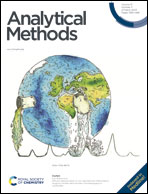Non-enzymatic electrochemical detection of creatinine based on a glassy carbon electrode modified with a Pd/Cu2O decorated polypyrrole (PPy) nanocomposite: an analytical approach
Abstract
The major constraints of standard enzymatic biosensors are poor long-term storage stability and high cost. Hence, there is extensive research towards fabrication of reliable enzymeless biosensors based on nanomaterials. In this paper, we present the development of an enzymeless electrochemical biosensor for highly precise detection of creatinine. This involves the use of a simple yet effective alternative to the commonly utilized Pd/Cu2O/PPy nanocomposite, which was characterized by different analytical methods. The present electrochemical sensor provides a wide detection range (0.1 to 150 μM), low detection limit (0.05 μM) and high sensitivity (0.207 μA), and is capable of detecting the creatinine level in human urine samples, which are inexpensive. The results are reproducible, and the sensor is stable. The sensor demonstrates good electrocatalytic activity and selectivity towards the detection of creatinine in the presence of various other similar biological entities. When compared to other existing counterparts, the electrocatalytic behaviour of the present sensor is comparable, if not better. So, the present electrochemical sensor for creatinine might be employed as a long-term diagnostic alternative.



 Please wait while we load your content...
Please wait while we load your content...